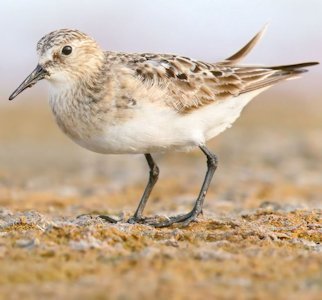
|
Bird Patterns of Development -- Page 2 Precocial parents need only lead the chicks to appropriate feeding habitats, keep them warm during the first days by occasional brooding, and protect them from predators This last job is especially critical. Since the chicks are moving around in open habitat, they are easily noticeable; because they are unable to fly, they are easy prey. Among shorebirds the solution is a combination of remarkable chick camouflage and energetic adult distraction displays. Baby shorebirds have special down feathers that create a finely spotted effect to break the outline of the chick, and their response to an alarm call from a parent to crouch, motionless, amid the vegetation. The parent then employs the rodent run, broken wing, or other distraction displays. The distraction displays are often so artful and insistent that the predator is drawn far away from the chick area. Afterwards, the parent circles back, giving the all-clear whistle, and gathers the brood together again. Many precocial waterfowl chicks are even better equipped to avoid predators because they can swim almost from birth. Baird's Sandpiper is a small to medium-sized sandpiper. Short neck. Moderately long, slightly drooping bill. Moderately long legs. Long wings extend past end of tail on resting bird. Dark center of rump and tail. Fairly distinct chest markings. Back scaly, with whitish edges to dark back feathers in some plumages. Their chicks are precocial. |
| Baird's Sandpiper | |
| ⇦ Back to Chick Development - Page 1 Return to Bird Nesting Choices On to Chick Development - Page 3 ⇨ | |